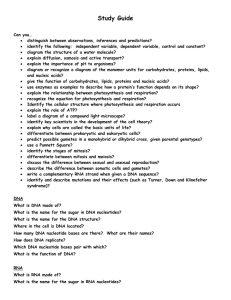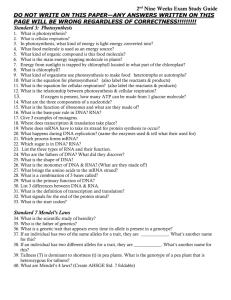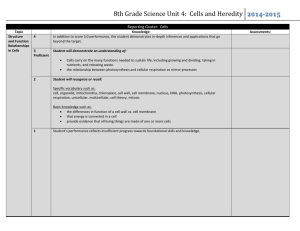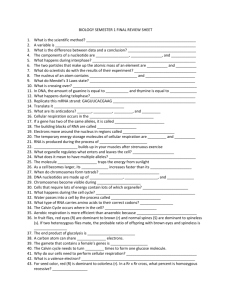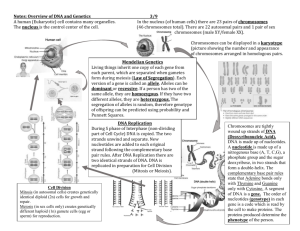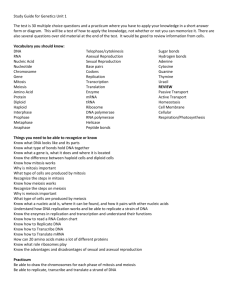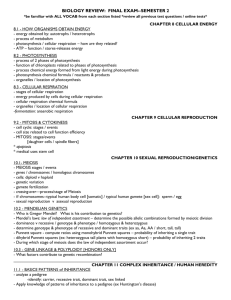Chapter 9 * Plants
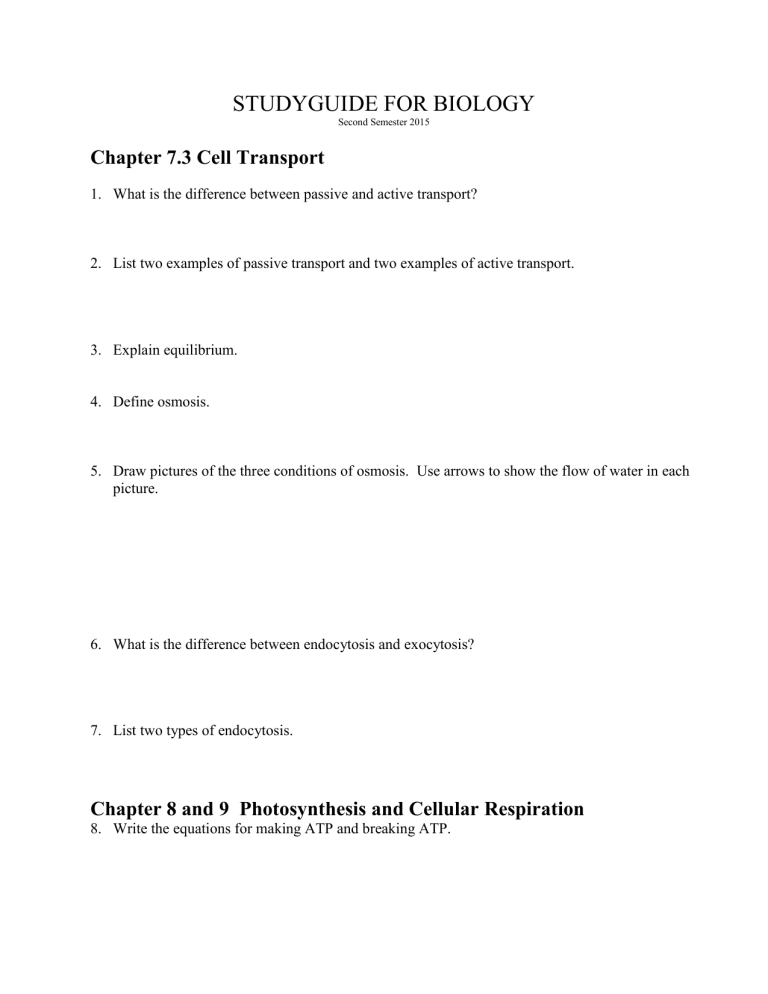
STUDYGUIDE FOR BIOLOGY
Second Semester 2015
Chapter 7.3 Cell Transport
1.
What is the difference between passive and active transport?
2.
List two examples of passive transport and two examples of active transport.
3.
Explain equilibrium.
4.
Define osmosis.
5.
Draw pictures of the three conditions of osmosis. Use arrows to show the flow of water in each picture.
6.
What is the difference between endocytosis and exocytosis?
7.
List two types of endocytosis.
Chapter 8 and 9 Photosynthesis and Cellular Respiration
8.
Write the equations for making ATP and breaking ATP.
9.
What are the parts of an ATP molecule?
10.
Write the equation for photosynthesis. (label all parts)
11.
Where does photosynthesis take place in a plant?
12.
Where does the carbon used in making carbohydrates during photosynthesis come from?
13.
Why do plants look green?
14.
Write the equation of aerobic respiration.
15.
Write the equation of anaerobic respiration.
16.
What are the two types of anaerobic respiration?
17.
Which type of anaerobic respiration can occur when you are exercising?
CHAPTER 10 Mitosis
18.
What are the parts of the cell cycle? Draw the cell cycle.
19.
Describe the three phases of interphase.
20.
What is mitosis? Describe the 4 phases involved in mitosis. Draw a picture of each stage.
21.
What is cytokinesis? When does this stage happen?
Chapter 11.4 Meiosis
22.
What is meiosis?
23.
How many times does meiosis go through the stages PMAT?
24.
What is the difference between haploid cells and diploid cells?
25.
Compare meiosis to mitosis.
26.
How many chromosomes are in a human egg or sperm?
27.
How many chromosomes are in a human body cell?
28.
If a shark egg has 14 chromosomes, how many will the body cell have?
29.
What sex chromosomes does a human male and female have?
30.
Explain the difference in meiosis of males and females.
CHAPTER 11 Mendel and Heredity
31.
Name two of Mendel’s laws.
32.
Distinguish between dominant traits and recessive traits.
33.
T = tall t = short Cross two heterozygous pea plants and give the genotype and phenotype for the cross.
34.
B = black W = white Cross a white with a gray rabbit. This is incomplete dominance. Give the genotype and phenotype.
35.
Mom is homozygous type A blood and dad is type AB blood. Give genotype and phenotype.
36.
Hemophilia is a sex-linked trait. Cross a female carrier with a normal male. Give genotype and phenotype of offspring.
Use the letters H and h for the pedigree.
37.
How many generations are in this pedigree?
38.
How many marriages are in the pedigree?
39.
What is the genotype of person 4?
40.
What is the genotype of person 7?
41.
How many males are in the pedigree?
42.
How many people have the trait?
43.
What is the relationship between person 2 and 8?
CHAPTER 12 DNA and RNA
44.
Draw a molecule of DNA. Label all the structures.
45.
What is the name of the structure of DNA?
46.
Explain how the bases of DNA pair together. (Chargaff’s rule).
47.
Explain the steps of DNA replication. Draw pictures if necessary.
48.
Who discovered the structure of DNA?
49.
What are the 3 parts of a nucleotide?
50.
What is the difference between DNA helicase and DNA polymerase?
51.
Give the complimentary DNA chain for the following: AATGCGCTATGCGGAT
52.
Definitions: a. transcription:
__________________________________________________________________ b. translation:
__________________________________________________________________ c. RNA polymerase:
__________________________________________________________________ d. tRNA: __________________________________________________________________ e. rRNA: __________________________________________________________________ f. mRNA: __________________________________________________________________
53.
Give the complimentary RNA strand to the following DNA strand.
ATCCGGAATGCTA
Use p303 to answer the following questions.
54.
Give two codons for cysteine.
55.
What amino acid does GAA code?
56.
Name 2 differences between DNA and RNA.


